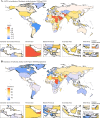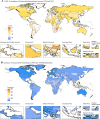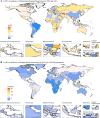Global burden of stroke in adolescents and young adults (aged 15-39 years) from 1990 to 2019: a comprehensive trend analysis based on the global burden of disease study 2019
- PMID: 39080669
- PMCID: PMC11289945
- DOI: 10.1186/s12889-024-19551-1
Global burden of stroke in adolescents and young adults (aged 15-39 years) from 1990 to 2019: a comprehensive trend analysis based on the global burden of disease study 2019
Abstract
Introduction: The incidence of stroke is rising among individuals aged 15-39. Insufficient research targeting this age group hampers the development of effective strategies. This study analyzes data from the Global Burden of Disease Study 2019 (GBD 2019) to examine trends from 1990 to 2019 and propose future interventions.
Methods: Data on ischemic strokes, intracerebral hemorrhage, and subarachnoid hemorrhage from 1990 to 2019 was collected from the Global Health Data Exchange (GHDx) platform. We used the Annual Average Percentage Change (AAPC) to assess global trends in incidence, prevalence, Disability-Adjusted Life Years (DALYs), and mortality rates across various stroke categories. Joinpoint models identified significant years of trend inflection. Trend analyses were segmented by age, gender, and Sociodemographic Index (SDI).
Findings: From 1990 to 2019, the global incidence of ischemic stroke within the adolescents and young adults (AYAs) cohort declined from 1990 to 1999, further decreased from 2000 to 2009, and then increased from 2010 to 2019. The overall AAPC p-value showed no significant difference. Mortality rates for ischemic strokes were consistently reduced during this period. The overall incidence rate of intracerebral hemorrhage has exhibited a downward trend. Meanwhile, the incidence rate of subarachnoid hemorrhage decreased from 1990 to 2009, yet saw a resurgence from 2010 to 2019. Male ischemic stroke incidence grew more than female incidence, but both absolute incidence and rates were higher for females. Differences in SDI levels were observed, with the fastest increase in incidence occurring in low-middle SDI regions, followed by high SDI regions, and the smallest increase in low SDI regions. Conversely, the most rapid decline was noted in high-middle SDI regions, with no significant change observed in middle SDI regions.
Conclusion: A concerning trend of increasing ischemic stroke incidence, DALYs, and prevalence rates has emerged in the global 15-39 age group, especially among those aged 30-39. This increase is evident across regions with varying SDI classifications. To combat this alarming trend among adolescents and young adults, enhancing preventive efforts, promoting healthier lifestyles, strengthening the healthcare system's responsiveness, and maintaining vigilant epidemiological monitoring is essential.
Keywords: Adolescents and young adults; Global burden of diseases; Intracerebral hemorrhage; Ischemic stroke; Stroke; Subarachnoid hemorrhage.
© 2024. The Author(s).
Conflict of interest statement
The authors declare no competing interests.
Figures






Similar articles
-
Global burden of subarachnoid hemorrhage among adolescents and young adults aged 15-39 years: A trend analysis study from 1990 to 2021.PLoS One. 2024 Dec 20;19(12):e0316111. doi: 10.1371/journal.pone.0316111. eCollection 2024. PLoS One. 2024. PMID: 39705242 Free PMC article.
-
Global and national burden of atherosclerosis from 1990 to 2019: trend analysis based on the Global Burden of Disease Study 2019.Chin Med J (Engl). 2023 Oct 20;136(20):2442-2450. doi: 10.1097/CM9.0000000000002839. Epub 2023 Sep 5. Chin Med J (Engl). 2023. PMID: 37677929 Free PMC article.
-
Global, regional, and national burden of stroke and its risk factors, 1990-2019: a systematic analysis for the Global Burden of Disease Study 2019.Lancet Neurol. 2021 Oct;20(10):795-820. doi: 10.1016/S1474-4422(21)00252-0. Epub 2021 Sep 3. Lancet Neurol. 2021. PMID: 34487721 Free PMC article.
-
World Stroke Organization (WSO): Global intracerebral hemorrhage factsheet 2025.Int J Stroke. 2025 Feb;20(2):145-150. doi: 10.1177/17474930241307876. Epub 2025 Jan 6. Int J Stroke. 2025. PMID: 39629687 Free PMC article. Review.
-
Global and regional burden of first-ever ischaemic and haemorrhagic stroke during 1990-2010: findings from the Global Burden of Disease Study 2010.Lancet Glob Health. 2013 Nov;1(5):e259-81. doi: 10.1016/S2214-109X(13)70089-5. Epub 2013 Oct 24. Lancet Glob Health. 2013. PMID: 25104492 Free PMC article. Review.
Cited by
-
Systematic analysis of the burden of ischemic stroke attributable to high LDL-C from 1990 to 2021.Front Neurol. 2025 Apr 4;16:1547714. doi: 10.3389/fneur.2025.1547714. eCollection 2025. Front Neurol. 2025. PMID: 40255889 Free PMC article.
-
Comparative analysis of stroke burden between ages 20-54 and over 55 years: based on the global burden of disease study 2019.BMC Public Health. 2025 Apr 5;25(1):1293. doi: 10.1186/s12889-025-22460-6. BMC Public Health. 2025. PMID: 40188028 Free PMC article.
-
Fermented dairy products intake and stroke risk: analyses of NHANES 2007-2018 data.Front Nutr. 2025 Jul 21;12:1593174. doi: 10.3389/fnut.2025.1593174. eCollection 2025. Front Nutr. 2025. PMID: 40761346 Free PMC article.
-
Rising tide: the growing global burden and inequalities of early-onset type 2 diabetes among youths aged 15-34 years (1990-2021).Diabetol Metab Syndr. 2025 Mar 27;17(1):103. doi: 10.1186/s13098-025-01673-0. Diabetol Metab Syndr. 2025. PMID: 40140909 Free PMC article.
-
The burden of intracerebral hemorrhage attributable to ambient particulate matter pollution in five Asian countries: a 32-year comparative analysis.BMC Public Health. 2025 Jul 15;25(1):2467. doi: 10.1186/s12889-025-23531-4. BMC Public Health. 2025. PMID: 40665299 Free PMC article.
References
-
- Feigin VL, Stark BA, Johnson CO, Roth GA, Bisignano C, Abady GG, et al. Global, regional, and national burden of stroke and its risk factors, 1990–2019: a systematic analysis for the global burden of Disease Study 2019. Lancet Neurol. 2021;20:795–820. 10.1016/S1474-4422(21)00252-0 - DOI - PMC - PubMed
MeSH terms
LinkOut - more resources
Full Text Sources
Medical

